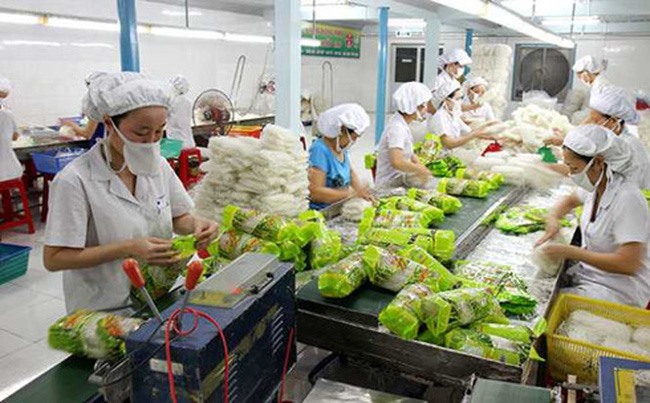 Economy
Economy

The export value of vegetables and fruits is estimated at US$1.7 billion in the first half of this year, marking a year-on-year increase of 45 per cent.
 |
| The export value of vegetables and fruits is estimated at US$1.7 billion in the first half of this year, marking a year-on-year increase of 45 per cent.— Photo baodautu.vn |
HÀ NỘI — The export value of vegetables and fruits is estimated at US$1.7 billion in the first half of this year, marking a year-on-year increase of 45 per cent.
A report from the Ministry of Agriculture and Rural Development (MARD) revealed that vegetables and fruits witnessed the highest growth in the export value of agricultural products, indicating their potential to increase value as well as brand name in the world market.
The country’s vegetables and fruits were exported to some 60 countries and territories and have become key export products of Việt Nam. Their export value is expected to increase to $3 billion this year.
China, the United States, Japan and South Korea are the four leading import markets of Vietnamese vegetables and fruits, accounting for 85 per cent of the total export value. During the period, impressive growth was witnessed in imports, including by Russia (67 per cent), Japan (56 per cent), China (50 per cent) and the United States (23 per cent), as well as South Korea (15 per cent) and Thailand (12 per cent).
Việt Nam’s vegetables and fruits not only maintained their growth rate in export, but also expanded their market.
According to the MARD’s Plant Protection Department, the first batch of large green mangoes grown in the northern mountain province of Sơn La will be exported to Australia this month.
The giant-sized fruit, priced at VNĐ22,000 (90 cents) per kilogramme, will be exported by Agricare Việt Nam Co., Ltd.
The department said the fruit was grown as per the Vietnamese Good Agriculture Practice (VietGap). The department cooperated with the Hanoi Irradiation Centre to irradiate 3.5 tonnes of Son La mangoes before shipping them to Australia on Wednesday.
“We sent the mango samples to our Australian partners, who appreciated the high quality, sweetness and unique flavour of the fruit,” a department representative said.
The export of Sơn La mangoes to Australia not only marks growth of the Vietnamese fruit in this market, but also opens opportunities for locals to develop agricultural production, especially orchards in northern mountain provinces such as Sơn La, where almost the entire population consists of ethnic minorities.
Director of Agricare Việt Nam Đàm Quang Thắng said the company was not competing in the ripe mango segment, which already had many foreign exporters. Meanwhile, Australia did not have many green mango products, therefore the company decided to invest in and develop this particular product.
“Sơn La is a northern mountainous area well-known for its mangoes and suitable for the growth of the giant mango variety on a large scale to export to Australia,” Thắng said.
Deputy chairman of Sơn La People’s Committee Lò Minh Hùng said the province had prepared plans to develop orchards, especially to grow mangoes, in recent years. The province currently had some 4,000ha of mangos, with productivity of more than 3,000 tonnes per year.
“The province will continue to support farmers to invest in the growth and production of mangoes according to market demand. If the market accepts the product, growers will expand production while businesses will be encouraged to join in exports,” Hùng said.
Agricare Việt Nam plans to ship some five tonnes of mango to Australia per week. This amount is not big, but with Australia "opening the door," other markets could follow suit.
Head of MARD’s Plant Quarantine Division Lê Sơn Hà said farmers previously were in the habit of growing and producing what they required, but now they would have to change their mindset, and focus on growing, treatment and packaging according to international standards and market demand.
“If Vietnamese fruit meets requirements to export to Australia and the United States, we believe our fruit can meet the demand of almost all world markets,” Hà said.
The province has set its key task, which is to develop orchards to replace short-term crops on hills to ensure sustainable living for local farmers. It expects to develop 100,000 ha of orchards by 2030, of which 50,000ha are for mango and the rest are for longan and avocado.
Hà said his department was working on procedures to ship lychee to Japan. At present, the country is already exporting longan to the United States, but it needed more time to further negotiate and complete procedures to export longan to Australia and New Zealand.
“Specifically, we will complete the process to export red-flesh and white-flesh dragon fruit to Australia this year,” Hà said.
The growth in export of agricultural products and seafood accelerated after the ASEAN-Australia-New Zealand Free Trade Area (AANZFTA) came into effect in 2010, which eliminated import duties.
The MARD, in collaboration with the Ministry of Industry and Trade, is working on ways to overcome technical barriers and open the Australian market to new fruits and types of shrimp. — VNS




